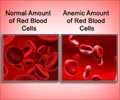The research opened new doors in the treatment of the genetic disease, Sickle cell anemia.
A research was conducted by Selda Samakoglu and colleagues at the Memorial Sloan-Kettering Cancer Center. This research opened new doors in the treatment of the genetic disease, Sickle cell anemia . The treatment combines both gene therapy and RNA interference therapy. So far the treatment has worked well in the laboratory stage and will be of great success in curing the disorder.
Sickle cell disease is a genetic disease affecting 80,000 people in the US alone. The Red Blood Cells (RBCs) become lose there normal disk shape and become sickle shaped. Due to this abnormality there is hindrance in the movement of these sickled RBC. The movement inside the small blood vessels is restricted and this results in piling, clumping inside the vessels. This eventually blocks the vessels leading to stroke, pain, infection and organ damage.This disease is very much prevalent among the Africans, Mediterranean, Indian or Middle Eastern individuals. At present the treatment is that the affected people are given a stem cell transplant from a donor. It is very difficult to find an exact mach and less than 20% of the children suffering from the diseases find a complete donor match.
The researchers said that at the moment they are working with animal model (mice) and after the tests results prove to be positive they will start human trails and bring about the treatment procedure in the main stream of medicine within a few years.
The stem cells taken from the bone marrow are cultured in the lab and a small RNA sequence that interferes with the production of beta S-globin is integrated. This is because this sequence that produces beta S-globin is altered in these patients hence the altered gene is prevented from getting translated to proteins. This set up is then inserted in a gene that promotes production of healthy hemoglobin chains.
The net result is the production of a transgene which is then inserted into a vector (virus) and is introduced into cell cultures. This virus is then taken into the stem cells of the sickle cell patients. After that the cells don’t produce beta S-globin but functions like the normal healthy Red Blood Cells. Further studies will be conducted even on the genetic disease Thalassemia which will be very useful in conducting human trials and studying the results of their sickle cell therapy.
The medical community appreciated the research and said the faster the cure more the lives will be saved. At present 1000 children are suffering from the disease and it would save their lives.
Advertisement











